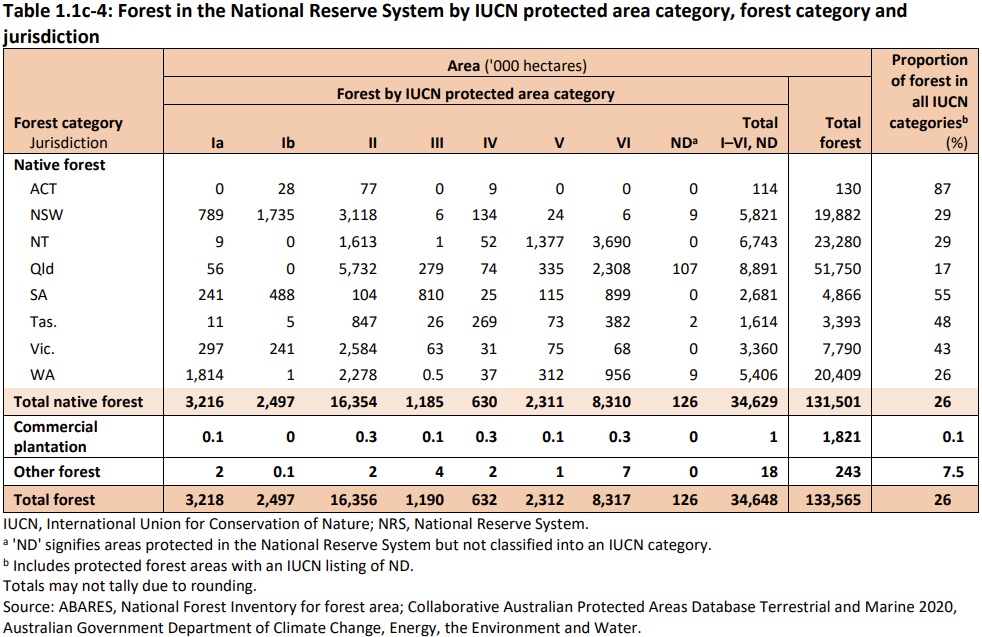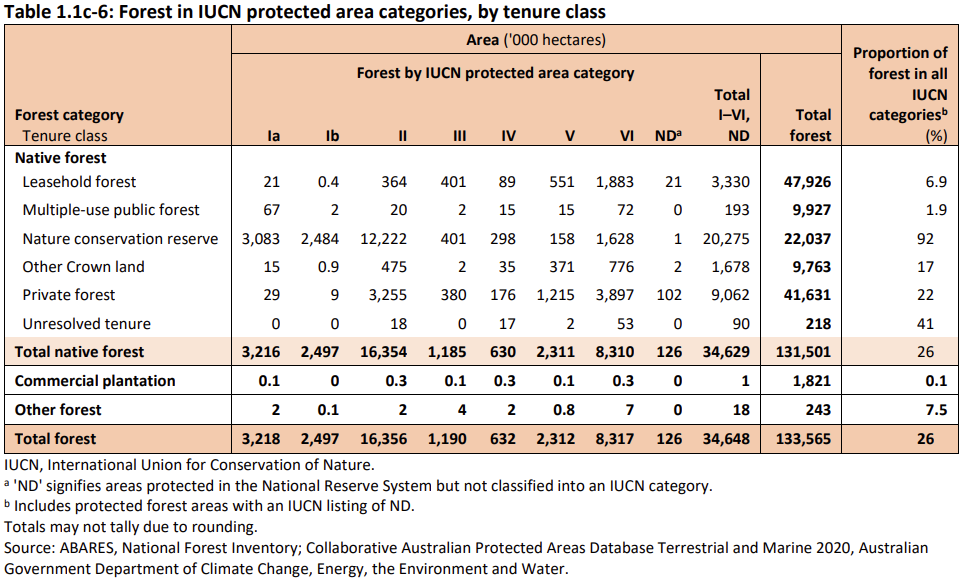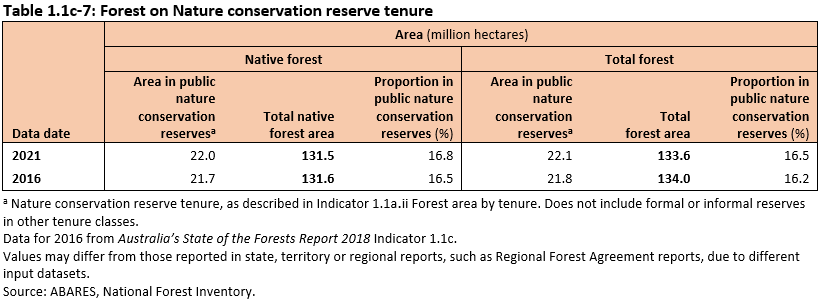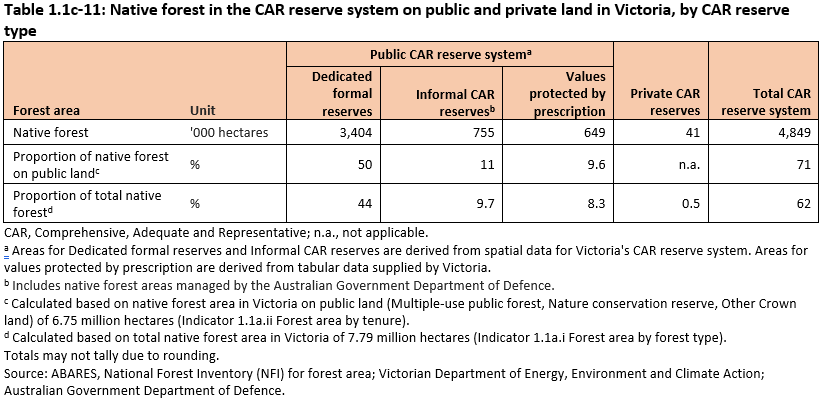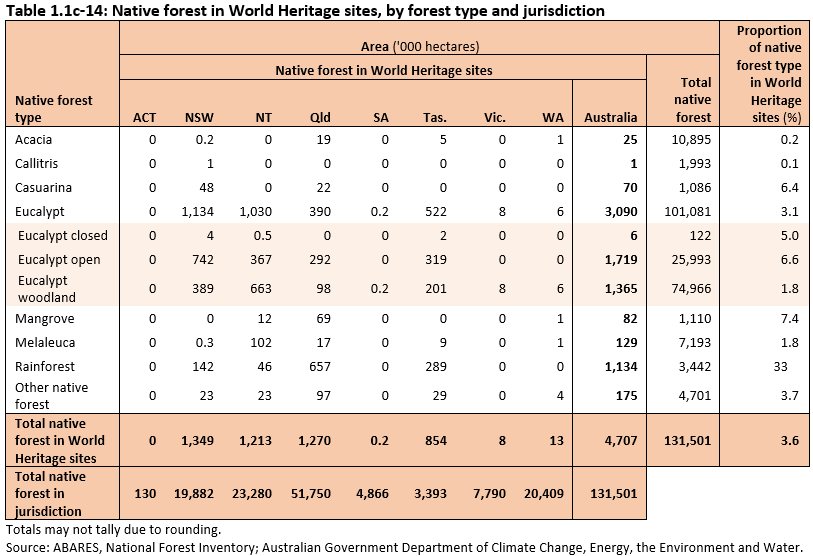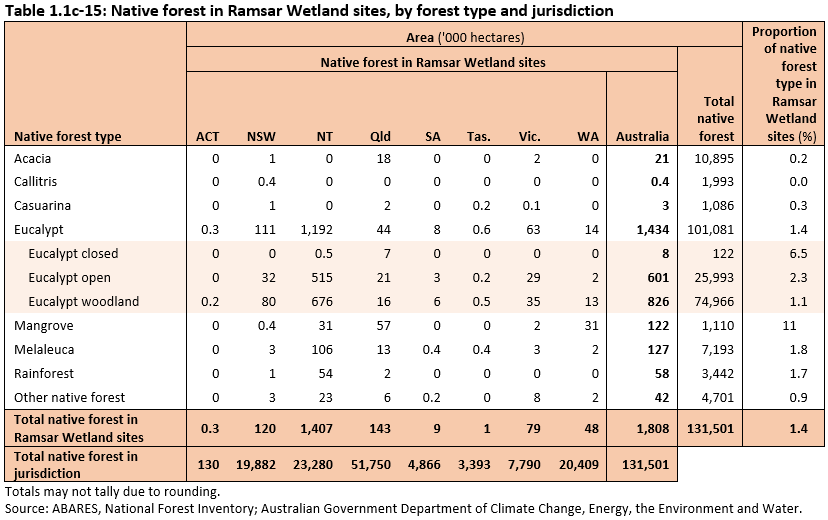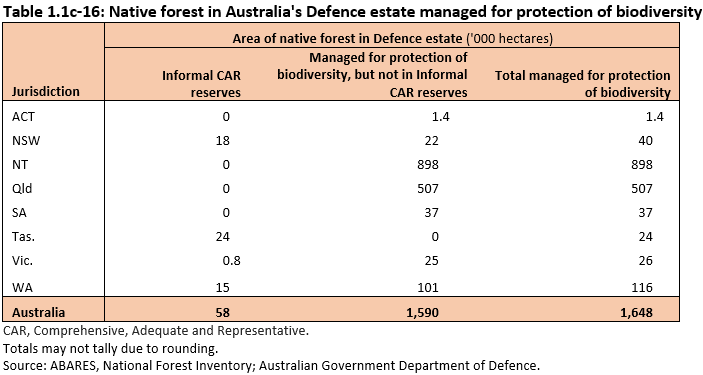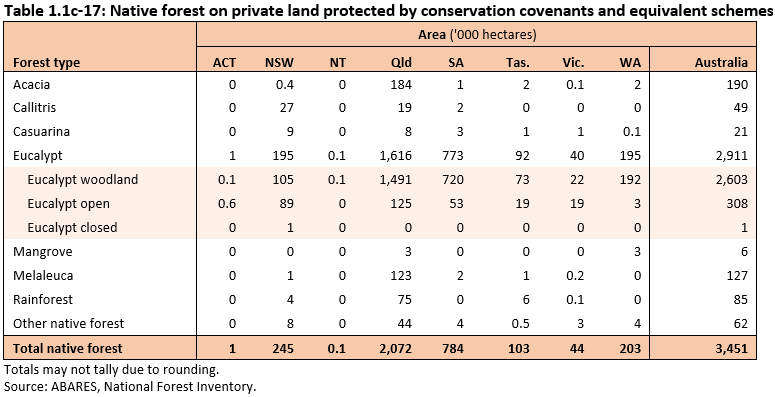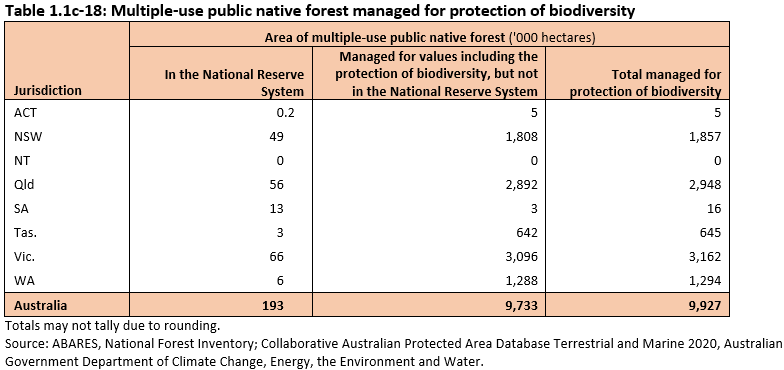This is Supporting information for Indicator 1.1c, published July 2024.
To be protected and included in Australia’s National Reserve System (NRS), an area of land must meet the International Union for Conservation of Nature (IUCN) definition of a protected area. These areas are assigned to an IUCN protected area management category (NRMMC 2009).
The categories used by the IUCN for protected areas are:
- Ia Strict nature reserve – protected area managed mainly for science
- Ib Wilderness area – protected area managed mainly for wilderness protection
- II National park – protected area managed mainly for ecosystem conservation and recreation
- III Natural monument – protected area managed for the conservation of specific natural features
- IV Habitat/species management area – protected area managed mainly for conservation through management intervention
- V Protected landscape/seascape – protected area managed mainly for landscape/seascape conservation and recreation
- VI Managed resource protected area – protected area managed mainly for the sustainable use of natural ecosystems.
The 34.6 million hectares of Australia’s forest protected in the NRS is shown by IUCN protected area category and jurisdiction in Table 1.1c-4, and forest type in Table 1.1c-5, and tenure class in Table 1.1c-6.
A total of 8.31 million hectares of native forest is in IUCN category VI, which covers areas where the sustainable use of natural resources is managed so that long-term protection and maintenance of biodiversity is assured (Dudley and Phillips 2006). This includes native forest managed privately, with 3.90 million hectares on Private forest and 1.88 million hectares on Leasehold forest (Table 1.1c-6). Examples include Indigenous Protected Areas where sustainable use of resources is permitted; and Nature Refuges in Queensland that protect conservation values, while allowing compatible and sustainable land uses to continue.
Areas of native forest on the Multiple-use public forest tenure class are included in the NRS if they are principally managed for the conservation of biodiversity. A total of 72 thousand hectares of Multiple-use public native forest is in IUCN category VI and includes areas of native forest on Forest Reserves in Queensland and Remote and Natural Areas in Victoria (Table 1.1c-6).
Click here for a Microsoft Excel workbook of the data for Table 1.1c-4.
Click here for a Microsoft Excel workbook of the data for Table 1.1c-5.
Click here for a Microsoft Excel workbook of the data for Table 1.1c-6.
The national land tenure class of Nature conservation reserve comprises publicly owned lands formally reserved for environmental, conservation and recreational purposes that are managed by state and territory governments. Conservation reserves on land held by Indigenous communities, including those with joint-management arrangements with the Australian Government, are included in the national land tenure class of Private forest (see Indicator 1.1a.ii Forest area by tenure).
A total of 22.0 million hectares of Australia’s forest is in the national land tenure class of Nature conservation reserve, which is 17% of Australia’s total forest area (Table 1.1c-7). This is 0.3 million hectares more than reported in Australia’s State of the Forest Report 2018 (SOFR 2018), due to a combination of more accurate tenure data for Western Australia, and transfer of land on other tenures to conservation reserves in New South Wales, Queensland and Victoria.
Information on Australia’s forest area by tenure class, and differences over time, is presented in Indicator 1.1a.ii Forest area by tenure.
Click here for a Microsoft Excel workbook of the data for Table 1.1c-7.
An objective in the National Forest Policy Statement is the dedication of parts of the forest estate for conservation based on the principles of comprehensiveness, adequacy and representativeness (CAR). The CAR reserve system that was developed was built on nationally agreed criteria (ANZECC and MCFFA 1997) and forms the scientific basis for the National Reserve System (see 1.1c Key information – Forest protected in Australia’s National Reserve System).
States that signed Regional Forest Agreements (RFAs; see Indicator 1.1a.iii Forest area in Regional Forest Agreement regions) (New South Wales, Tasmania, Victoria and Western Australia) as well as the Australian Capital Territory report their protected areas by the four CAR reserve system components:
- Formal (dedicated) reserves: areas, such as a national park, legally dedicated for protection in a reserve.
- Informal reserves: reserves on public land protected through an administrative instrument by a public land management agency, such as special protection zones in state forests.
- Values protected by prescription: areas of public production forests in which protection of values is prescribed through management prescriptions in codes of practice or management plans. These values are typically not mappable in advance of their detection, and/or inclusion in dedicated or informal reserves is impractical, such as riparian vegetation or rare, dispersed or fragmented values.
- Private CAR reserves: areas of private land that are managed in the long term for the protection of CAR values under secure arrangements, including under legislation and contractual agreements such as conservation covenant and management agreements for conservation.
The extent of native forest on components of the CAR reserve system both inside and outside RFA regions are reported for the Australian Capital Territory, New South Wales, Tasmania, Victoria and Western Australia in Tables 1.1c-8 to 1.1c-12. The areas of native forest in the CAR reserve system are:
- Australian Capital Territory: 120 thousand hectares (92% of total native forest in jurisdiction)
- New South Wales: 6.11 million hectares (31%)
- Tasmania: 2.09 million hectares (62%)
- Victoria: 4.85 million hectares (62%)
- Western Australia: 5.50 million hectares (27%).
The total area of native forest in the CAR reserve system across Australia is 18.7 million hectares (14% of the total area of native forest in Australia) (Table 1.1c-3).
Click here for a Microsoft Excel workbook of the data for Table 1.1c-8.
Click here for a Microsoft Excel workbook of the data for Table 1.1c-9.
Click here for a Microsoft Excel workbook of the data for Table 1.1c-10.
Click here for a Microsoft Excel workbook of the data for Table 1.1c-11.
Click here for a Microsoft Excel workbook of the data for Table 1.1c-12.
Native forest in the CAR reserve system in RFA regions
A key outcome from the RFA process was the development and implementation of the CAR reserve system within RFA regions. A total of 10.8 million hectares of native forest is in the CAR reserve system in the 10 RFAs (Table 1.1c-13). This is 53% of native forest in RFA regions (Table 1.1c-13). The RFA regions with the highest proportion of native forest in the CAR reserve system are the:
- Tasmanian RFA region (62% of RFA region native forest is in the CAR reserve system)
- West Victoria RFA region (56%)
- Southern NSW RFA region (55%).
Click here for a Microsoft Excel workbook of the data for Table 1.1c-13.
UNESCO World Heritage sites
The World Heritage Convention establishes a list of places that have natural and/or cultural values of outstanding global significance. As at 2021, Australia had a total of 20 sites inscribed on the World Heritage List. The most recent addition of an Australian site on the list was the Budj Bim Cultural Landscape that was inscribed in 2019.
World Heritage sites on mainland Australia include a total of 7.72 million hectares, including 4.71 million hectares of native forest. A total of 3.6% of Australia’s native forest area is in World Heritage sites; this includes 33% of Australia’s rainforests (Table 1.1c-14).
The largest areas of native forest in World Heritage sites are in:
- New South Wales (1.35 million hectares)
- Queensland (1.27 million hectares)
- the Northern Territory (1.21 million hectares) (Table 1.1c-14).
Click here for a Microsoft Excel workbook of the data for Table 1.1c-14.
Ramsar Wetlands of International Importance
The Convention on Wetlands of International Importance (the Ramsar Convention) is the intergovernmental treaty that provides the framework for the conservation and wise use of wetlands and their resources. Australia is a member state of the Convention and as at 2021 has 67 Ramsar sites.
Ramsar Wetland sites cover a total of 1.81 million hectares of native forest (1.4% of Australia’s the total native forest area), of which 1.41 million occurs in the Northern Territory.
By forest type, the largest area in Ramsar Wetland sites is Eucalypt forest (1.43 million hectares), while the Mangrove forest type has the greatest proportion of its total area in Ramsar Wetland sites (11%) (Table 1.1c-15).
Click here for a Microsoft Excel workbook of the data for Table 1.1c-15.
The Australian Government Department of Defence manages a large area of land across all jurisdictions, including Defence bases, establishments and training facilities. The Defence Environmental Strategy specifies biodiversity conservation as a management intent as part of a suite of strategic aims to deliver sustainable environmental management for all land managed by Defence.
A total of 1.65 million hectares of native forest is on the Defence estate, and all is managed for the protection of biodiversity. Of that area a total of 58 thousand hectares of native forest is also within a Regional Forest Agreement (RFA) region through the RFA process, this area is identified as Informal CAR reserve on Commonwealth land (Table 1.1c 16).
Click here for a Microsoft Excel workbook of the data for Table 1.1c-16.
A conservation covenant is a voluntary agreement made between a landholder and an authorised entity (such as a covenant scheme provider) that aims to protect and enhance the natural, cultural and/or scientific values of an area of land. Reserves established under a conservation covenant and equivalent schemes are important for the protection of rare or endangered species or other important values. Conservation covenants typically occur on privately managed land and complement protected areas on publicly managed land.
A total of 3.45 million hectares of native forest is on land subject to a conservation covenant or equivalent scheme. A total of 2.91 million hectares of this native forest is eucalypt forest, of which 2.60 million hectares is eucalypt woodland. Queensland has the largest area of native forest on land under a conservation covenant, with 2.07 million hectares (Table 1.1c-17).
A number of state and territory organisations undertake conservation covenanting programs. Information presented here uses data from the New South Wales Biodiversity Conservation Trust, Queensland Trust for Nature, Trust for Nature (Victoria) and National Trust of Western Australia, and additional data from state and territory governments on other equivalent schemes with privately managed protected areas.
Information on areas managed by national conservancy organisations such as the Australian Wildlife Conservancy and Bush Heritage Australia are not reported here, but are included in the National Reserve System and thus captured in the Key information for Indicator 1.1c – Forest protected in Australia’s National Reserve System.
Click here for a Microsoft Excel workbook of the data for Table 1.1c-17.
The national land tenure class of Multiple-use public forest comprises publicly owned forests that provide a range of services such as wood harvesting, supply of water, protection of biodiversity, and recreation. The principles of ecologically sustainable forest management (ESFM), including protection of biodiversity, are specified for multiple-use public forests by all states and the ACT (there is no multiple-use public forest in the Northern Territory), either in legal frameworks that prescribe their sustainable management, or in management planning instruments that provide operational guidance for sustainable forest management practices. Further information on legal frameworks and management planning instruments that support sustainable forest management are reported in Indicator 7.1a.
All native forest on multiple-use public forest tenure is protected or otherwise managed with protection of biodiversity as one of several goals. A total of 193 thousand hectares of Multiple-use public native forest managed principally for the protection of biodiversity is included as protected areas in the National Reserve System (Dudley and Phillips 2006). Management of the balance of multiple-use public forest (9.73 million hectares) (Table 1.1c-18) is regulated by codes of forest practice in order that of a range of forest values are maintained, including protection of biodiversity.
Click here for a Microsoft Excel workbook of the data for Table 1.1c-18.
ANZECC and MCFFA (Australian and New Zealand Environment and Conservation Council/Ministerial Council on Forestry, Fisheries and Aquaculture) (1997). Nationally Agreed Criteria for the Establishment of a Comprehensive, Adequate and Representative Reserve System of Forests in Australia. Report by the ANZECC and MCFFA National Forest Policy Statement Implementation Sub-committee, Australian Government, Canberra.
Department of Defence (2016). Environmental Strategy 2016 – 2036. Australian Government, Canberra.
Dudley N (ed) (2008). Guidelines for Applying Protected Area Management Categories. Gland, Switzerland: IUCN.
Dudley and Phillips (2006). Forests and Protected Areas: Guidance on the Use of the IUCN Protected Area Management Categories. International Union for Conservation of Nature, Gland, Switzerland, and Cambridge, UK.
NRMMC (Natural Resource Management Ministerial Council) (2009). Australia’s Strategy for the National Reserve System 2009–2030. Australian Government, Canberra.
UNEP CDB (United National Environment Programme Convention on Biological Diversity) (2018). 14/8 – Protected areas and other effective area-based conservation measures. Decision adopted by the Conference of the Parties to the Convention on Biological Diversity Fourteenth meeting, Sharm El-Sheikh, Egypt, 17 to 29 November 2018.
Further information
Click here for Key information on Indicator 1.1c: Area of forest in protected area categories (2024), including:
- Mechanisms for protection of forest biodiversity
- Forest protected in Australia’s National Reserve System
- Native forest managed for protection of biodiversity
- The Convention on Biological Diversity and Australia’s '30 by 30' target

